Varroa infested colonies entered the United States in ~1987, and changed beekeeping forever. Beekeeping has always been time consuming, difficult and experience oriented; however, beekeeping became even more challenging when beekeepers were called to eradicate a bug on another bug. Since its introduction in the US, beekeepers have reported high annual colony losses due to mites. In fact, some beekeepers report 60% losses due to this troublesome pest. While beekeepers have faced devastating challenges before, including American Foulbrood, Varroa mites has presented damages never before seen.
Varroa have become more difficult to manage since their introduction. The mites are seemingly embedded within the honey bee industry reality as nearly, if not all, colonies have Varroa. Like many beekeepers say: ” all my colonies have mites, I just cannot see them”. Even if alcohol washes do not reveal mites, Varroa is present in the brood or will be present soon due to infestation from surrounding colonies. As mites have become more widespread, they became a vector for a variety of viruses. In fact, researchers are finding more and more variants of Deformed Wing Virus (DWV), a virus that affects the honey bee’s essential flight capabilities. Research has shown that DWV-B (Deformed Wing Virus variant B) can be responsible for high over-winter losses.
The point here is that Varroa devastates colonies. It would also seem that Varroa are transmitting more virulent strains of viruses with each passing year. Because of this, I recommend to keep mite levels below 1 mite/ 100 bees in the spring and below 3 mites/100 bees in the fall. With Varroa loads any higher, beekeepers risk high colony losses.
Monitor, Monitor, Monitor
Beekeepers must consistently monitor mites if they expect to have strong and healthy colonies. Beekeepers can monitor their mites in various ways, but I recommend both of these two methods: perform an alcohol wash (or other monitoring method) and observe the overt signs of mite damage. It is ideal to perform monitoring methods once a month, but we realize this is not always possible. Because of this, combining both monitoring and observation methods are recommended. Ideally, mites should be monitored at least 4 times a year. As seen in Figure 1: population increase, population peak, population decrease, and fall dormant; it is essential to understand the seasonal changes. For example, brood density varies throughout the year, so certain treatments can be less effective at different times. By understanding seasonal cycles, beekeepers can better manage their mites. I understand Figure 1 does not reflect the reality of every region but it gives a good overall general idea. Some regions have multiple population peaks due to large honey flows, so you will need to understand the honey bee seasonal phases in your region. But essentially, as the bee and brood population increase, so do the mites.
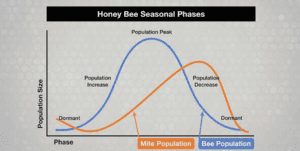
Mite Monitoring Techniques
I attached a chart outlining the 3 major mite monitoring techniques I recommend. Perform one of these techniques 4 times a year: Early spring, late spring, late summer and early fall. Each beekeeper has their preference, so use the method you feel the most comfortable with. I use alcohol washes, but I feel comfortable with sugar rolls or CO2 as well. As long as you monitor, there is not a wrong method!
| Advantages | Disadvantages | |
| Sugar Rolls |
|
|
| Alcohol Wash |
|
|
| CO2 |
|
|
When monitoring for mites, beekeepers should review mite thresholds. I outline my recommended thresholds for each monitoring method below. If your colony is above threshold, I recommend taking actions. Mite thresholds are not an exact science, even if you have levels below the threshold, it is no assurance that your colonies will be healthy and successful. For example, I have sampled many commercial beekeepers with mite levels <0.5 mites /100 bees in the spring, and they eventually had huge losses. I typically see mite levels spike in the late summer because: A) summer treatment with honey supers are limited, B) Mites are often lurking in the brood, and C) Mites from other beekeepers nearby can (re)infest colonies. Because of this, always monitor and monitor again. Once mite levels do spike, they may be difficult to bring down. Too often, when you notice, the mite damage is already done. I should note that I recommend alcohol washes, powdered sugar rolls or CO2 over a sticky board. Sticky boards are not nearly as accurate, because they do not quantify the level of infestation. If a sticky board is your only option, you can attest that you have some mites or more mites, but you are not able to assess the level of infestation (1, 2, 3 mites/100 bees). Use other monitoring method options for more accurate results and an infestation level to compare with suggested thresholds. *These thresholds may vary per US regions. These are the threshold I recommend in the Midwest (MN & ND)
| Monitoring Method | # of mites in early-spring | # of mites in mid-spring | # of mites in late-spring | # of mites in early-fall | # of mites in late-fall |
| Alcohol Wash |
1 mite/100 bees |
1 mite/100 bees | 1 mite/100 bees | 3 mite/100 bees | 3 mite/100 bees |
| Powdered sugar roll | 1 mite/100 bees | 1 mite/100 bees | 1 mite/100 bees | 3 mite/100 bees | 3 mite/100 bees |
| CO2 | 1 mite/100 bees | 1 mite/100 bees | 1 mite/100 bees | 3 mite/100 bees | 3 mite/100 bees |
| Sticky Board | 9 mites/24 hours | 9 mites/24 hours | 9 mites/24 hours | 12 mites/24 hours | 12 mites/24 hours |
Mite related Disease Progression
I inspect and observe hundreds of colonies annually. When I enter a colony, I often immediately know whether it has (or did) have high mite levels simply by observing progressed signs of mite damage. Just observing progressed mite damage does not suffice, but it is a good start. By noting visual signs of Varroa, you will know just how important your mite levels are and the need for action. Monitoring is best but if you can recognize some of the visual signs, you will better understand the extend of the mite damage to your colony.
I outlined the 5 stages of mite damage, which I relay to my beekeepers. In the spring during population increase, I want to see colonies within the Stage 1- 2. While I hate to see mites in the spring, this is not always a bad sign. Even if I observe mites, the colony may be below the recommended threshold, so just continue to monitor that colony. During the late spring, summer and fall, I like to see colonies within Stage 1-3. Even if Chewed Down brood (CDB) (outlined below) and phoretic mites are seen, it does not mean that beekeepers have high levels. However, a combination of phoretic mites and CDB can signal worse mite issues. If these signs are seen, continue to monitor these colonies. As for Stage 4-5, I never want to see these stages, regardless of temporal period. Deformed Wing Virus (DWV) and Varroa Mite Syndrome (formerly Parasitic Mite Syndrome or PMS) can signify high mite levels. Specifically for Varroa Mite Syndrome, it signifies very progressed mite damage, which often results in colony deterioration and eventual colony death. If colonies are in stage 4 or stage 5, monitor immediately to determine extent of damage. Action is often required, but may be too late.
| Stage | Visual Signs | Notes |
| Stage 1 | Zero signs of mites, brood diseases or viruses | |
| Stage 2 | Visual signs of phoretic mites on either workers or drones.
|
This does not necessarily mean a mite issue exists, but if mites are seen, monitor to determine extent of varroosis.
|
| Stage 3 | Chewed Down Brood and/or phoretic mites
|
|
| Stage 4 | Deformed Wing Virus (DWV) and/or Chewed Down Brood and/or signs of phoretic mites. | Visual signs of Deformed Wing Virus (DWV) can mean larger varroa issues. Obviously, this depends upon the number of bees with DWV and the number of phoretic mites seen, but mite monitoring is recommended to determined extent of varroosis. These signs signal a more progressed form of varroosis. |
| Stage 5 | Varroa Mite Syndrome (VMS) and/or Deformed Wing Virus (DWV) and/or Chewed Down Brood and/or Phoretic mites | Visual signs of Varroa Mite Syndrome usually signal extreme issues with varroasis. If Varroa Mite Syndrome is seen, then mite levels are often a significant issue and has advanced to the most progressed stage of varroosis. |
Visual signs
Phoretic Mite
Phoretic mites are Varroa mites seen on the abdomen of worker (or drone bees). Most phoretic mites, however, are found underneath the bee, more precisely tucked between the abdomen’s sclerites where they latch on and feed. Because of this, I typically inspect the ventral abdomen of several worker bees during inspections. This is why beekeepers “never see mites”, even if these beekeepers have higher mite levels. Visually inspect phoretic mites just on the workers, not the drones. If phoretic mites are seen on worker bees, then this represents a more progressed infestation of mites. Signs of phoretic mites indicate the colony is in Stage 2-5. Visually inspect other signs to further pinpoint extent of damage.
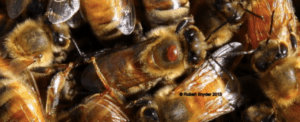
Chewed Down Brood (CDB)
Bees can sense mites in the brood. If sensed, bees will uncap and cannibalize the pupae. If CDB is seen, then mites may be at a high level, especially within the brood. CDB can indicate progressed mite damage, so continue to monitor and assess colony health.
Deformed Wing Virus (DWV)
Deformed Wing Virus (DWV) represents the next stage of varroosis progression. Bees with DWV are kicked out of the colony so if bees with DWV are seen than Varroa has become an issue. DWV does not signify un-manageable mite levels for the colony, but it is a more progressed sign of mite damage.
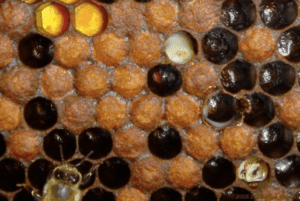
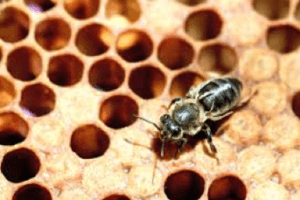
Varroa Mite Syndrome (VMS)
A pathogen has not been identified for this diseased, however mites are always present when this disease is seen. This brood symptom looks similar to other brood diseases except the larvae do not rope like foulbrood. Larvae do appear sunken to the side of the cell. If Varroa Mite Syndrome is observed, then colony has likely dwindled and deteriorated. Varroa Mite Syndrome is the most progressed sign of mite damage, and truly at a stage of no return. Even if low phoretic mites are seen, Varroa mite syndrome often means an end to your colony, even if treatment is applied.
Symptoms
- Spotty brood and Varroa present on adult
- Mites may be present on brood
- Mites seen on open brood cells
- Small population size
- No odor present, just sunken brood
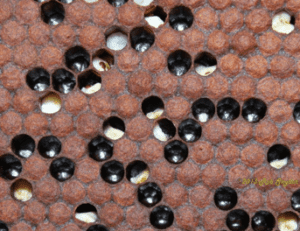
Summary
All beekeepers should consistently monitor mites throughout the year. Even if mite levels are low at one point, it does not mean they will stay low. Mite levels can easily spike, so always be aware and monitor and re-monitor. Beekeepers should learn how to monitor and visually inspect for mites. By doing so, varroa mites can effectively be managed. Varroa mites are the most challenging issue beekeepers face, so make sure you know where your colonies stand. If you don’t, then you risk losing your colonies.
Cheers!
Garett Slater
BIP Tech Transfer Team Member
University of Minnesota
Note: This blog was posted by Anne Marie Fauvel but written by Garett Slater